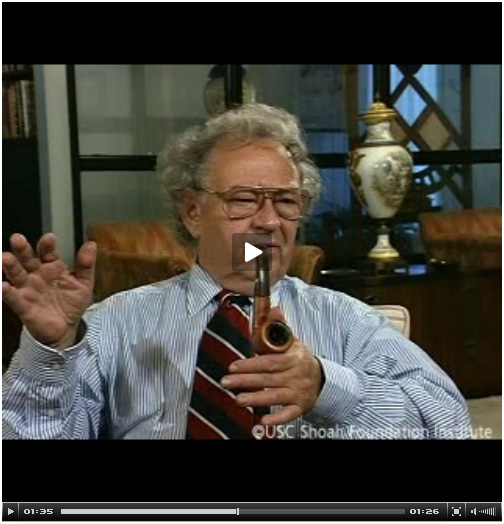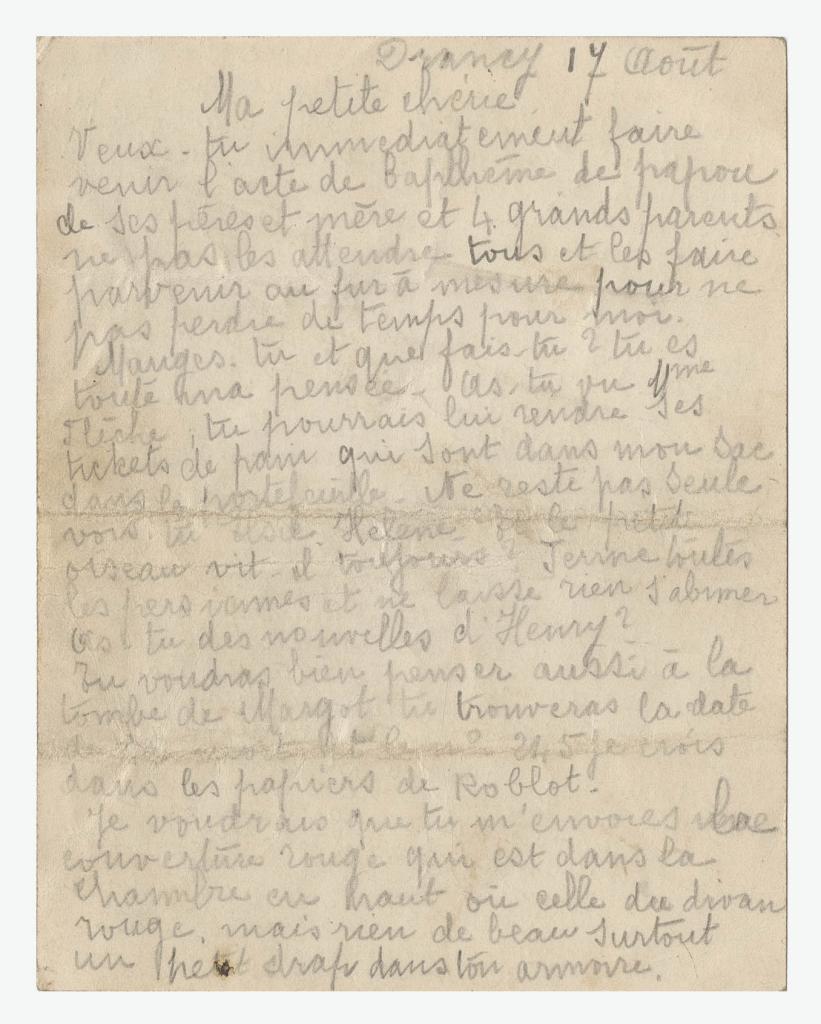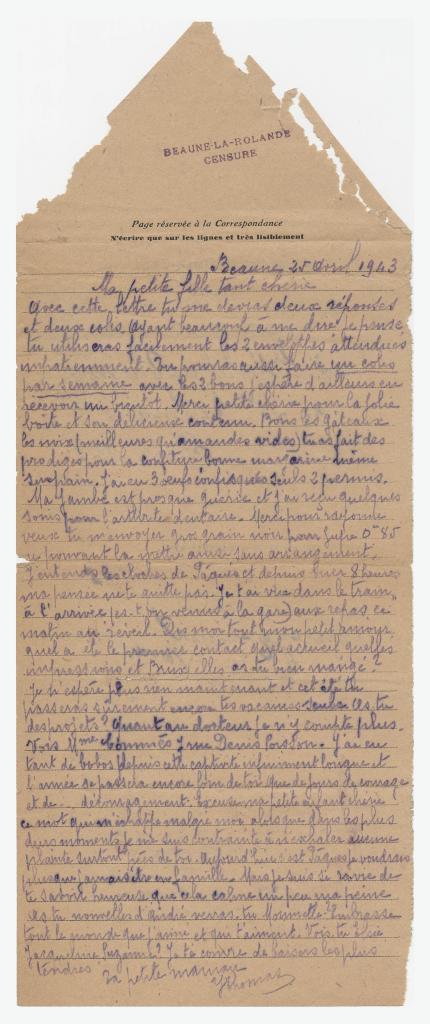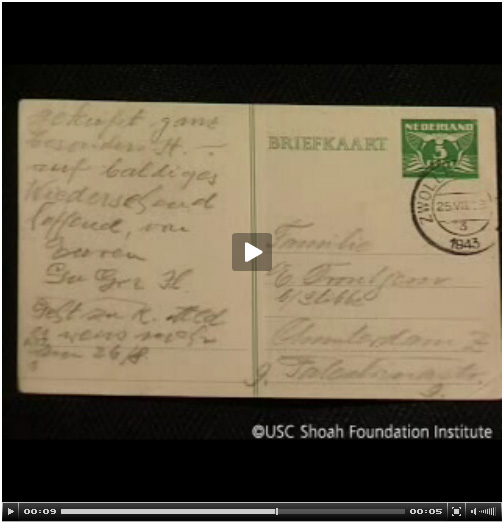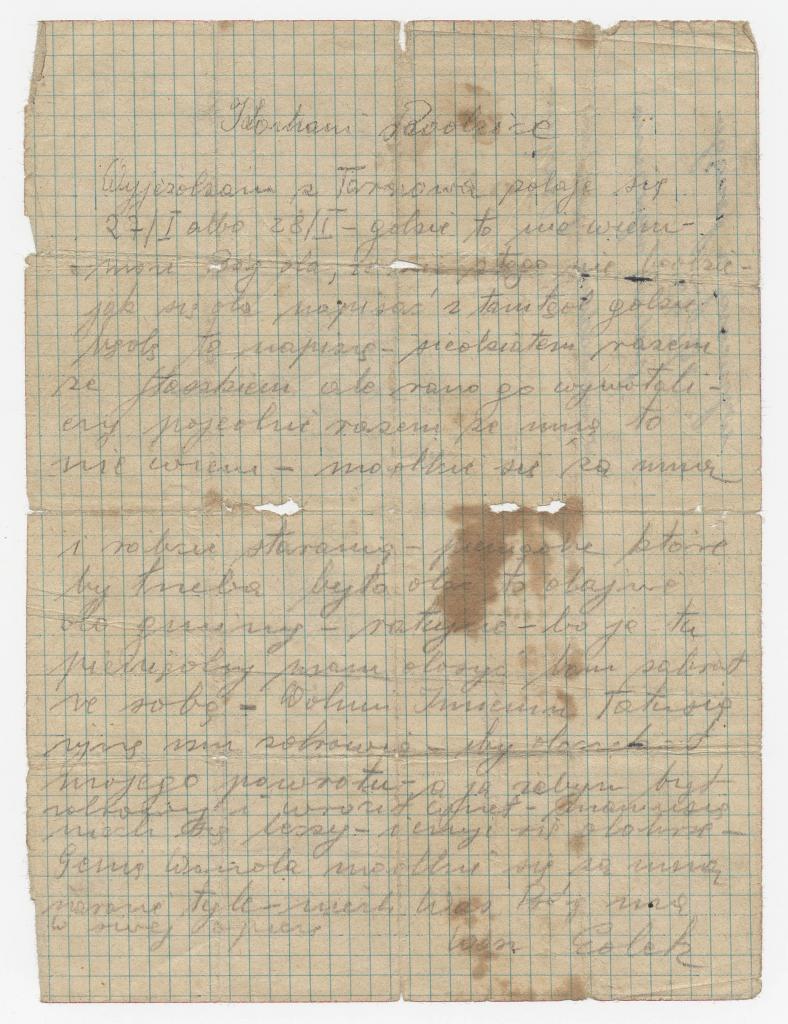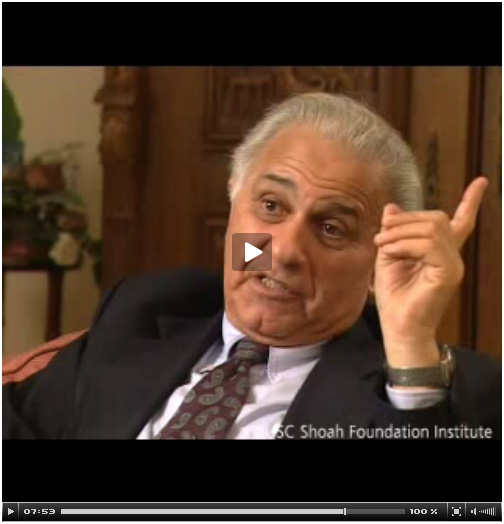Among the monstrous net of concentration camps created by Nazi Germany over occupied Europe, there were also so-called transit camps. As opposed to other camps, these places were not intended either for extermination or for labour but as waiting points where prisoners (mostly, Jews) were collected to be sent further, mostly, to Auschwitz-Birkenau. They were located for the most part in Western Europe, such as Westebork in the Netherlands, Drancy and Beaune-La-Rolande in France, Mechelen in Belgium, and Theresienstadt in Czechoslovakia. The conditions of these camps were a bit better than the rest of concentration camps; in some of them (in Theresienstadt and Westerbork) various cultural activities were allowed; in some transit camps in France the prisoners were even allowed to be visited by their relatives. However, people lived under the constant fear of deportation to Poland, and this is the main emotion that characterizes the diaries and letters of these camps’ inmates.
This case study commemorates the prisoners of transit camps whose letters are kept at the archive. We will look at people being in transition – mostly to their fate but also at those that managed to fulfill an enormous task of escaping not only the transit camps but also Auschwitz. All prisoners were typically in transition, and the majority of camp correspondents went through at least two or three camps. Also, the prisoners who were deported under the program “Night and Fog” (Nacht und Nebel) were secretly taken to Nazi camps and executed there. The main goal of Nacht und Nebel was to make political prisoners disappear without a trace. The ones who were not executed were continuously transferred between camps. However, the inmates of transit camps were in transition by nature, always being aware of the coming deportation to other and worse places.
The Nazis often deceived people by luring them into transports and saying that they were being taken to some safe place; instead, the transport would go to the extermination camps. Ruth De Wilde remembers how, after having spent some time at the collection camp in Berlin, they were told that they were going to Switzerland but in reality the transport went to Auschwitz. She managed to smuggle a note to her parents through the Dutch truck driver.[*] The role of Theresienstadt, the Jewish Ghetto in Czechoslovakia, was to show the world (and particularly, the Red Cross) that Jews are being well-treated; in 1944, the commission of the Red Cross visited Theresienstadt; soon after that thousands of ghetto inmates were deported to Auschwitz. The survivors of Drancy also note that despite knowing about the persecutions of Jews in Europe they could not perceive the degree of danger that awaited them. Also, people were deceived by the cards that were sent from the east to convince them that the deportees are still well and alive:
There was a kiosk in front of administrative building with the Jewish personnel working there, and they posted letters sent to those persons... These were cards postmarked from Germany, saying “Dear so and so, we are doing well, we work hard on the farm... we work very hard from day till night but the kids are very happy, we have all the food we want.” ... We did not realize that by that time this person was already in the gas chamber, the minute he got there. These letters calmed the people, and the ladies in the kiosk would say – oh yes, I knew Ms. Cohen, or Ms. Kahn, I am getting cards from them all the time. These people did not know either ... Who would have thought that they forced the people to write the letters before sending them to the gas chambers? We would believe the story until the moment when we got to the cattle cars.[*]
The Brisebois collection holds a number of letters sent from different transit and internment camps located in the occupied France, such as Beaune-La-Rolande; Chateaubriant-Choisel; Gurs; Le Vernet D’arièges, and Drancy. The camp of Drancy, founded in August 1941, became the biggest “hub for deporting Jews to the east, and new detainees kept on arriving there every day.”[*] People would spend some time there, but in many cases, they would stay there only for a day or two, and later, be sent further to the east. Yvonne Thomas was imprisoned in Drancy in 1942, and in 1943 transferred to Beaune-La-Rolande. Her letters are addressed to her daughter Micheline, probably a teenager or even a young adult. As with all other prisoners, she sends her detailed requests for food parcels and clothes.
As opposed to the unified style of letters from German concentration camps, letters from Drancy are written in a looser manner. First of all, the correspondents were allowed to write in French, and second, censorship was not as strict as in other places. While not going into details, M-me Thomas gives her daughter various hints of information about her life in Drancy, including the state of her health, or even camp restrictions:
I had 3 eggs confiscated, [since] only 2 are permitted; received your parcel, I am waiting impatiently, especially for the clothing, since 14 days passed without having changed and washed. Sleep has become unknown to me and tonight is the only day since my departure when I have rested for several hours. In so little time I have become an old woman, everyone has found that I have aged 20 years and it is not rare that someone supposes me to be 54 to 55 years old; I am unable to see anyone ... sthere are 5000 of us and I don't know any names. Oh, I am so lonely.[*]
In contrast to the obligatory positivity of mail coming from Dachau or Ravensbruck, Yvonne openly talks about being hungry, sick, and physically exhausted (As for me, with my 44 kg, my head is better), and about the regulations that do not allow her to receive more than two eggs at a time. Also, she desperately tries to obtain the documents that would secure her release. In the first letters coming from Drancy (probably, soon after her incarceration) she asks Micheline to “send for the baptism certificate of father, his brothers and mother and 4 grandparents, do not wait at all and send them as soon as they are available so that I do not lose any time [here].”[*] Later, she sends instructions on how to obtain the confirmation of her Aryan descent: When you have received the baptism certificates, photograph them, take to the Bureau of Jewish Affairs... and send this to me by registered mail. Keep the original close to you. Don't lose any time. And then, a year later, after spending some time in Drancy and having been transferred to another camp, M-me Thomas still nurtured some hope, though one can see by her writing that it was waning: There have been many releases these days in my block. When will mine be? Will we spend our vacations together?[*]
Yvonne Thomas was able to stay for several months at the transit camps and to avoid deportation to the east; probably, because of being only half-Jewish, she got into the category of people who were protected from transports. In late 1942 or early 1943 she was transferred to Beaune-la-Rolande, another transit camp, which at that time was “used to detain those that the Germans transferred in from Drancy because they were not (at least not at the time) “deportable.”[*] Unfortunately, there is no data on her further fate. There is a possibility that she died in the camp, since the last letter says “you will surely take your vacations alone again ... According to the doctor I am no longer well ... I have had so many injuries since this infinitely long captivity and the year has again passed far from you.[*] Beaune camp was officially closed on July 12, 1943, and the prisoners were transferred to Drancy, which by that time was in the full control of the SS.
Some people did not have even this brief pause between deportations, and spent only one or two days at Drancy, on the way to Auschwitz or Sobibor death camps. In these cases, the prisoners were allowed to send a brief message to their loved ones indicating that they were being deported to some unknown destination. Such is the note written by Mr. Lerman to his friends or relatives in Paris saying that he is being sent further:
My dear friends, Mrs and Mr. Deudon. I am in good health. I wish the same for you. I will always count on your friendship. I will say good bye since I am leaving soon. I will send you news. Wishing you well, Lerman.[*]
Michel Brisebois proposes three candidates that could be Mr. Lerman (we do not know his first name) , of which Azmiel Lerman seems to be the most likely candidate. Born in Poland, he moved (probably fled) to France, was arrested in August 1942 during the large roundups in Paris, and perished in Auschwitz.[*]
While not knowing exactly their destination, people sensed the upcoming doom and tried to send their last notes to the outside world. The VHA survivors list many occasions of how they or their relatives when being deported would throw a letter out of a train, and how these messages would get to the addressees. Ernest Nives, as a Drancy survivor, identifies that as an “indicative of the anxiety we had to let people know where we were going to go and...it shows also that we didn't know where we going to go.” Another VHA interviewee shows a postcard that her uncle and aunt threw out of the train while being deported to the east (none of them returned).[*] The Brisebois collection also holds one such letter written by the Polish prisoner Edek (Edward) Sowa who threw his letter when being transferred from the Gestapo prison in Tarnow (Poland) to Auschwitz:
I am leaving from Tarnow, they say the 27th of January or the 28th of January --- where I don't know. Maybe God will prevent anything from happening. If it will be possible to write from there, I will write. I was in jail with Staszek, but in the morning they called him out. I don¹t know if he is going with me ---pray for me and do make efforts [to help me] ... That's all for now -- may God have you in His care.[*]
Edward died two months later in Auschwitz, on March 4, 1943. These letters of people written on the brink of horrible death transmit to our times the horror of the person being put into an “absolute cold and cruel barbaric place.”[*]
Most of the deportees realized what fate was awaiting them when being put into the sealed cattle trains. All former inmates of Drancy describe the horrendous contrast between the relatively civilized transit camp where they were brought by regular passenger trains and the cattle cars filled with straw and with two buckets for people to relieve themselves. Leo Bretholz in a VHA interview talks about the utter dehumanization that one experienced on those trains. While realizing what fate awaits them, Leo and his friend succeeded in the daring and risky attempt to escape the train:
On the train, we tried to move the bars in the train, they did not, but they were rusty. We took off our sweaters and dipped them in the human waste, and twisted the sweaters around the window bars. We alternated with my friend. After several hours the bar started moving, and then we used our arms to twist them until we could squeeze through the windows. We escaped in the Champagne region of France. We waited for the curve so that the train would slow down, and tumbled into the ravine. We were noticed: the train came to a halt, there were shots and lights; the third fellow that was supposed to fly with us did not make it. We walked into a village, it was dark. We went into a village and stopped at the priest’s house, we spent a night there.[*]
Even when being already imprisoned in Auschwitz, some people managed to escape. The collection holds the letters of two persons, Aleksander Martyniec and Antoni Wykret. Both of them successfully escaped from the camp by means of dressing as civilian workers or even as SS guards. Antoni Wykret arrived at Auschwitz I with the first group of men “from the prison in Tarnow by the Krakow Sipo and SD commander.”[*] In 1944, he, together with Henryk Kwiatkowski disguised themselves as SS officers and on September 9 fled from the camp with the group of Polish prisoners and joined the Home Army’s Sosienka Partisan Unit. Later, Wyrket and S. Furdyna, wearing SS uniforms, intercepted a horse cart carrying two prisoners and three guards. Passing themselves off as functionaries of the camp Gestapo, they conducted a thorough search of the cart, examined the pass of the SS guard and told him they were taking the prisoners with them for interrogation by the Gestapo.” [*] During the SS raid on the partisan unit Wykret was wounded and arrested but as soon as he regained consciousness he escaped from the truck that was taking him back to Auschwitz.[*]
Leonard Zawacki, also a camp escapee who fought in the same resistance unit as Antoni Wykret, describes in a VHA interview the complex planning of their escape from Auschwitz:
One day (after weeks of preparations) we changed into the SS uniforms and left our prisoners clothes (the prisoners said they would burn them as soon as we leave). Disguised as SS men we walked through the camp, met a group of prisoners that was waiting for us, told them in German to pick up the tools and march in front of us. Since we did not have proper passes (they were the wrong color), we did not go through the gate but took a “shortcut” and went to the tower with the SS guards. The guard waved, and we passed to the other side. There was a search afterwards but they did not find us.[*]
As pointed out by Henryk Swiebocki in Anatomy of Auschwitz, the more precisely the prisoners planned their flight, the more chance they had to get away not only in the process of escaping but also after that, since many people were afterwards captured and executed.[*] Aleksander Martyniec, whose letter is also a part of the Brisebois Collection, described in the post-war account how accurately his flight was planned by him and his friend, Jan Sarapata. They managed to disguise themselves as civilian workers and fled through the civilian canteen.[*]
Being on the transport on the way to death or being constantly in transfer under the threat of gas chambers, or flying from camps or trains with the hope of deliverance, their letters show us only one thing, the state of utter terror in the face of unnamed doom. Those who survived described later hours and days spent inside the sealed cattle cars as the most horrible and scary experiences of their lives. The mixture of hope and fear, and the bitter realization of us today that very few were spared and lived to see the end of the concentration camps is epitomized in the transit camp and Gestapo prisons correspondence.
NOTES
[1] De Wilde, Ruth, Interview 8503, Visual History Archive. USC Shoah Foundation Institute. 2012. Web. 15 March 2012
[2] Metz, Gilbert, Interview 45926, Visual History Archive. USC Shoah Foundation Institute. 2012. Web. 15 March 2012
[3] Poznanski, Renee, Jews in France During World War II. Trans. by Nathan Bracher. Hannover and London: Brandeis University Press and U.S. Holocaust Memorial Museum, 2001, 309.
[4] Poznanski, Renee, Jews in France During World War II. Trans. by Nathan Bracher. Hannover and London: Brandeis University Press and U.S. Holocaust Memorial Museum, 2001, p. 319
[5] The Central Database of Shoah Victims Names, Yad Vashem, http://db.yadvashem.org/names/search.html?language=en
[6] De Wilde, Ruth, Interview 8503, Visual History Archive. USC Shoah Foundation Institute. 2012. Web. 15 March 2012
[7] Nives, Ernest, Interview 588, Visual History Archive. USC Shoah Foundation Institute. 2012. Web. 15 March 2012
[8] Bretholz, Leo, Interview 8503, Visual History Archive. USC Shoah Foundation Institute. 2012. Web. 15 March 2012
[9] Czech, Danuta. Auschwitz Chronicle, 1939-1945. New York : H. Holt, c1990.
MILLS Research Collections: D 805 .P7 C8713 1989, p. 13
[10] Henryk Swiebocki, “Prisoner Escapes, Anatomy of the Auschwitz Death Camp, Yisrael Gutman, Michael Berenbaum, eds. United States Holocaust Memorial Museum: Indiana University Press, 510
[11] Czech, Danuta. Auschwitz Chronicle, 758-759
[12] Zawacki, Leonard, Interview 37183, Visual History Archive. USC Shoah Foundation Institute. 2012. Web. 15 March 2012
[13] Henryk Swiebocki, “Prisoner Escapes, Anatomy of Auschwitz, 506
[14] Martyniec, Aleksander, Nasza Ucieczka (Our Escape), Numery Movia (The Numbers Speak). Wydawn. "Slask"; Wyd. 3 edition, 1986
